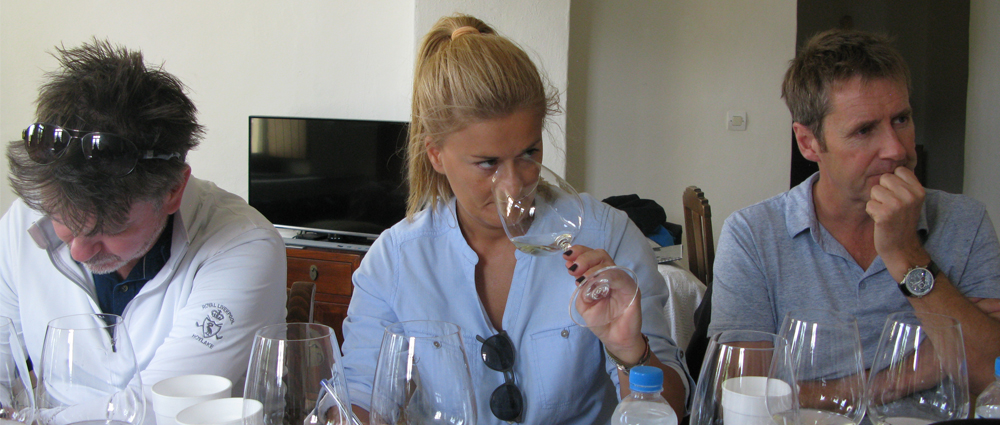
British Masters of Wine Cast Their Verdict on T-Oinos Estate
Last week we travelled to the Greek Cyclades island of Tinos, home to one of the most exciting prospects in world fine wine production – T-Oinos Vineyards – and we were joined by a group of British Masters of Wine, visiting to give their expert help and advice to this up and coming estate.
Amongst the group were Lenka Sedlackova MW and Demetri Walters MW of Berry Bros & Rudd, Greg Sherwood MW of Handford Wines and Justin Knock MW of Philglas & Swiggot, with the trip organised and led by Greece’s energetic and charismatic MW, Yiannis Karakasis.
The day started with a visit to T-Oinos’ 450 metre altitude, granite boulder-strewn Clos Stegasta vineyard, located in the mountainous centre of Tinos island. Usually 4 – 5 degrees cooler than at sea level, windswept and often foggy in the morning, the vineyard endures the kind of marginal climate that seems often to be associated with the finest and most distinctive regions for wine production around the world.

Tasting The Reds:
Suitably impressed with the uniqueness of Clos Stegasta’s terroir, the MWs dropped by winemaker Spyros Zoumboulis’ house in nearby village Falatodos to taste the estate’s reds, vinified from indigenous Cyclades grape variety Mavrotragano.
The variety has previously been best known for the heavy and often overly-tannic wines produced from the grape in Santorini, but the Tinos version was showing as far silkier, more elegant and luscious, with incredible concentration of fruit balanced by ripe, velvety tannins. Demetri Walters MW was particularly impressed, describing the 2013 as the best example of Mavrotragano he had tasted to date.

And Then The Whites:
After what the Greeks described as a “light lunch” the party broke up for the afternoon, before reassembling in the evening at a restaurant in Chora to taste a vertical selection of T-Oinos’ Clos Stegasta Assyrtiko, with each vintage on show from 2011 to 2015.
What was particularly interesting was how quickly the question of quality was settled; whilst several of the MWs admitted thinking in advance that they would be offering advice on how a middling but ambitious estate could improve its output, as soon as the first few vintages were tasted, this was no longer a concern. The acclaim for the wines was universal and the debate quickly moved on to issues of the estate’s best style.
Whereas T-Oinos’ reds had quickly settled into a distinctive form, recognisable from vintage to vintage, there were significant differences in the style of the Clos Stegasta Assyrtiko each year, not entirely explainable by vintage variation.
Oenologist Thanos Fakorelis put forward that this was in large part due to the arrival of new equipment in the winery, with 2013 – a particularly oaky wine – the first year they had used new oak fermentation vessels. With the second year of use in 2014 and particularly the third in 2015, this overt oakiness had settled down, with more of the natural minerality of the Assyrtiko grape coming to the fore.
The MWs were split between those who preferred the more oaky style, seeing it as more commercially appealing to an audience used to drinking barrel-aged Burgundies and those who favoured the terroir-specific character of the steelier, more mineral early years.
A Good Problem To Have?
Discussing this matter afterwards with winemaker Spyros Zoumboulis, he saw this as a good problem to have. His view was that, as long as people feel that the basic quality of the wine is present – which the MWs clearly did – then stylistic concerns could be settled over time. With the tank samples of 2016 we tasted in the winery very close in form to the beautifully-balanced 2015, it seems that this question is already well on the way to being answered.


